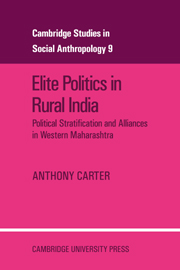 Elite Politics in Rural India
Elite Politics in Rural India from Part 3 - Political alliances
Published online by Cambridge University Press: 02 March 2010
In this and the two subsequent chapters I will analyse the political action which I observed in Girvi, Phaltan Taluka, and Satara District between February 1966, when I went to live in Girvi, and September 1967. This was a hectic period in local politics. In Girvi a new Panchayat was elected early in 1966 and a new Credit Society Managing Committee was elected later in the same year. A General Election was held throughout India in January 1967 and in Maharashtra there were zilla parishad and panchayat samiti elections in May 1967. More than half of the villages in Phaltan Taluka elected new panchayats in April 1967 and in Phaltan a new Municipal Council was elected in May 1967. I will not attempt to narrate the political history of this period. Rather I will show how the pattern of political aliances which emerged in these elections and in connected events is related to the social structure of the region and to the arenas and occasions of political action.
Decisions concerning political alliances are made in terms of such antecedent structural frameworks as the governmental and administrative systems, the caste system, the economic system, and the kinship system. An analysis of these systems in Western Maharashtra reveals a fifth and fundamental structural framework which runs through all the others. This structural framework is the division of the population into two categories: the mass of the population with little or no political influence and a small political class consisting mainly of potentially influential, high status, well connected, and wealthy v∂t∂ndar Marathas.
To save this book to your Kindle, first ensure [email protected] is added to your Approved Personal Document E-mail List under your Personal Document Settings on the Manage Your Content and Devices page of your Amazon account. Then enter the ‘name’ part of your Kindle email address below. Find out more about saving to your Kindle.
Note you can select to save to either the @free.kindle.com or @kindle.com variations. ‘@free.kindle.com’ emails are free but can only be saved to your device when it is connected to wi-fi. ‘@kindle.com’ emails can be delivered even when you are not connected to wi-fi, but note that service fees apply.
Find out more about the Kindle Personal Document Service.
To save content items to your account, please confirm that you agree to abide by our usage policies. If this is the first time you use this feature, you will be asked to authorise Cambridge Core to connect with your account. Find out more about saving content to Dropbox.
To save content items to your account, please confirm that you agree to abide by our usage policies. If this is the first time you use this feature, you will be asked to authorise Cambridge Core to connect with your account. Find out more about saving content to Google Drive.